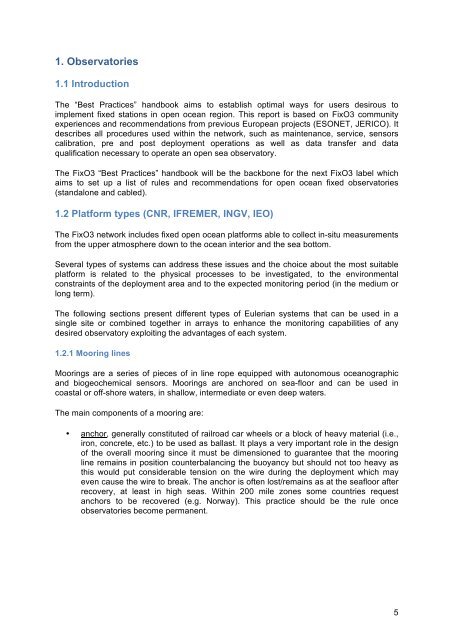Handbook of best practices
Handbook%20of%20best%20practices
Handbook%20of%20best%20practices
Create successful ePaper yourself
Turn your PDF publications into a flip-book with our unique Google optimized e-Paper software.
1. Observatories<br />
1.1 Introduction<br />
The “Best Practices” handbook aims to establish optimal ways for users desirous to<br />
implement fixed stations in open ocean region. This report is based on FixO3 community<br />
experiences and recommendations from previous European projects (ESONET, JERICO). It<br />
describes all procedures used within the network, such as maintenance, service, sensors<br />
calibration, pre and post deployment operations as well as data transfer and data<br />
qualification necessary to operate an open sea observatory.<br />
The FixO3 “Best Practices” handbook will be the backbone for the next FixO3 label which<br />
aims to set up a list <strong>of</strong> rules and recommendations for open ocean fixed observatories<br />
(standalone and cabled).<br />
1.2 Platform types (CNR, IFREMER, INGV, IEO)<br />
The FixO3 network includes fixed open ocean platforms able to collect in-situ measurements<br />
from the upper atmosphere down to the ocean interior and the sea bottom.<br />
Several types <strong>of</strong> systems can address these issues and the choice about the most suitable<br />
platform is related to the physical processes to be investigated, to the environmental<br />
constraints <strong>of</strong> the deployment area and to the expected monitoring period (in the medium or<br />
long term).<br />
The following sections present different types <strong>of</strong> Eulerian systems that can be used in a<br />
single site or combined together in arrays to enhance the monitoring capabilities <strong>of</strong> any<br />
desired observatory exploiting the advantages <strong>of</strong> each system.<br />
1.2.1 Mooring lines<br />
Moorings are a series <strong>of</strong> pieces <strong>of</strong> in line rope equipped with autonomous oceanographic<br />
and biogeochemical sensors. Moorings are anchored on sea-floor and can be used in<br />
coastal or <strong>of</strong>f-shore waters, in shallow, intermediate or even deep waters.<br />
The main components <strong>of</strong> a mooring are:<br />
• anchor, generally constituted <strong>of</strong> railroad car wheels or a block <strong>of</strong> heavy material (i.e.,<br />
iron, concrete, etc.) to be used as ballast. It plays a very important role in the design<br />
<strong>of</strong> the overall mooring since it must be dimensioned to guarantee that the mooring<br />
line remains in position counterbalancing the buoyancy but should not too heavy as<br />
this would put considerable tension on the wire during the deployment which may<br />
even cause the wire to break. The anchor is <strong>of</strong>ten lost/remains as at the seafloor after<br />
recovery, at least in high seas. Within 200 mile zones some countries request<br />
anchors to be recovered (e.g. Norway). This practice should be the rule once<br />
observatories become permanent.<br />
5


